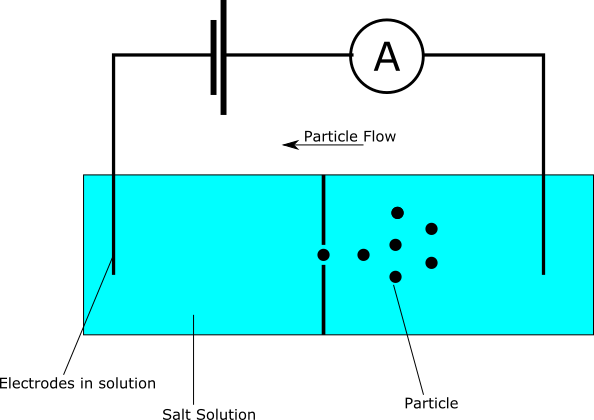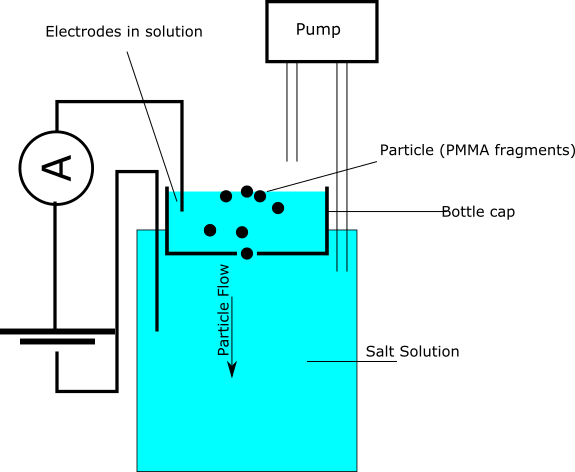Coulter counter/nanopore demonstrator

I wanted to knock together a quick visible demonstration of the nanopore/coulter counter sensing technique. This post documents a demonstrator using bits I had knocking around the house…
What is Ionic/Nanopore sensing?
(Ionic) Nanopores and coulter counters are devices that let you electrically detect the passage of small particles though a hole. The “hole” (pore, aperture) sits between two chambers which are filled with a conductive fluid. A voltage is then passed between the chambers and a current flows through the pore. Anything that passes through the pore blocks this current flow. So by measuring the current, you can detect the passage of particles through the pore. When a particle is in the pore, the current can’t flow as well as usual. So you get a short, drop in current as the particle blocks the pore.

Big particles block the aperture more than small ones. And you can therefore also get size information. This principle is used in the coulter counter to measure particle size distributions (for example to get white blood cell counts, or understand the distribution of particle in paints, or printer toner).
Building a macropore!
The basic sensing method described above works at a range of scales. All the way from millimeters down to nanometers. To get a feel for the basic principle lets build a macropore!

I used a bottle cap, which I made a ~2mm hole in (I used an old soldering iron, but a drill would be better). The toothpicks in the side (completely blocking small holes), are to hold the “pore” in place later.
Next we need something to put though the pore. Most plastics are lighter than water and will just float and wont want to go through the pore. PMMA (acrylic) isn’t. But where I am it’s difficult to find PMMA pellets/granules.
So, with a pair of old wire cutters I cut up some acrylic sheet:

Then we can build our fludic system. We’re essentially going to build what was shown in the schematic at the top of the page. But there’s something missing, a way to drive particles through the pore. In this setup, we’ll use gravity.
The bottle cap will sit on top of beaker (or jar). It needs to be held in place, so the bottom of the cap with the hole in is completely submerged. But most of the bottle cap needs to be above the water line. If we add solution to the bottle cap it will then flow down into the bottom beaker.
For my setup I added a pump (cheap peristaltic pump from ebay) to recirculate the solution. Here’s the setup in schematic form. This is essentially the same figure as shown at the top of the page:

Below is the actual setup in all it’s glory! In my setup I used 1M KCl, about 7.5g of KCl in 100mL of DI water. I used AgCl electrodes (silver wire that’s been sitting in bleach for ~30mins).

I also needed to add a small barrier to help direct particles to the hole. Without this particles tend to get trapped in the fluid flow and spin in circles around the pore without going down it. I used a small piece of microscope cover glass:

You can then put a bias voltage across the electrodes and monitor the current. I used a oscilloscope to view the current trace. The scope has a built in function generator which I used to generate a 1v DC bias voltage.
Current was monitored using a self built transimpedance amplifier with a 1K feedback resistor. This was based around an LMP7721. But probably any FET opamp in a transimpedance configuration will work.
In the video above you can see the system working. As I pipette in some solution, you should see a small black particle fall down into the beaker. At roughly the same time, you should see a small upward “blip” on the oscilloscope, as the particle translocates the pore.
The PMMA particles tend to float on the surface tension. So I’m pipetting solution on top of the particle to make it sink.
Hopefully this provides a basic visual demonstration of the “pore” or coulter counter sensing approach. If you’re interested in ionic sensing, you should signup for Demonpore. Demonpore is making a molecular gaming platform which lets users experiment with pore based sensing. And my desire to experiment with macropores here comes out of discussions we’ve had around explaining nanopore sensing in visual and compelling ways.